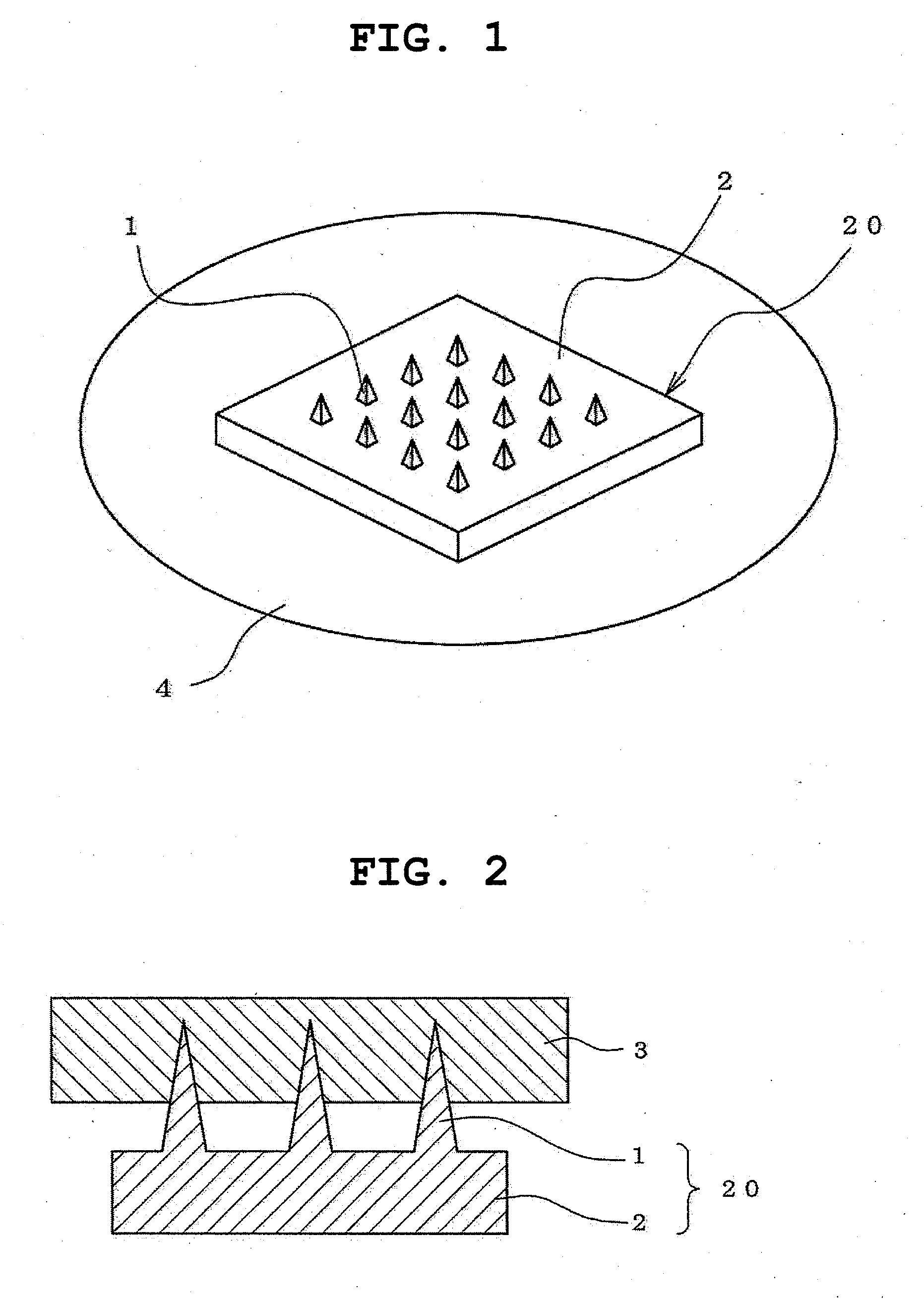Process for producing microneedle of thermosensitive substance
a thermosensitive substance and microneedle technology, applied in the field of microneedles, can solve the problems of high manufacturing cost, poor reliability in obtaining uniform microarrays, difficulty in obtaining appropriate hardness, etc., and achieves the effects of reducing manufacturing costs considerably, easy maintenance of product specifications, and convenient performan
- Summary
- Abstract
- Description
- Claims
- Application Information
AI Technical Summary
Benefits of technology
Problems solved by technology
Method used
Image
Examples
example 1
Production of Polylactic Acid Resin Microneedle
[0107]A silicon microneedle (a jig wherein 12×12 prismatic microneedles with 100 μm sides, 300 μm in length, were placed in array on 7 mm×7 mm square substrate) was placed on a hot plate and heated at 80° C.
[0108]A polylactic acid (Mw: 10,000) was thermally molten on an aluminum substrate and cooled to yield a tabular sheet.
[0109]The polylactic acid sheet was placed on the support pillar of a Shimadzu rheometer (EZ-TEST) with its top down. The support pillar was pulled down to bring the jig into contact with the sheet to make the temperature-sensitive material at the contact portion viscoplastic. The support pillar was kept at that position for 5 seconds, and then pulled up at a rate of 5 mm / minute.
[0110]When the resin sheet was pulled up, a resin microarray (microneedle) having acicular projections with nearly uniform length of 300 μm was obtained (FIG. 9).
example 2
Production of Maltose Microneedle
[0111]Maltose was thermally molten on an aluminum substrate and cooled to yield a tabular sheet. Using this sheet, a microarray (microneedle) was prepared by the same method as Example 1. The hot plate heating temperature was 150° C., the duration of contact of the jig with the sheet was 5 seconds, and the support pillar raising rate was about 50 mm / minute.
[0112]When the resin sheet was pulled up, a microarray of maltose having microneedles of uniform length was obtained (FIG. 10).
example 3
Production of Polylactic Acid Resin Microneedle
[0113]A silicon microneedle (a jig wherein 12×12 quadrangular prismatic microneedles with 100 μm sides, 300 μm in length, were placed in array on 7 mm×7 mm square substrate) was placed on a hot plate and heated at 80° C.
[0114]A polylactic acid (Mw: 10,000) was thermally molten on an aluminum substrate and cooled to yield a tabular sheet.
[0115]The polylactic acid sheet was placed on the support pillar of a Shimadzu rheometer (EZ-TEST) with the top on. The support pillar was pulled down to bring the jig into contact with the sheet, and the support pillar was kept at that position for 7 seconds. Subsequently, the support pillar was pulled up by about 2 mm at a rate of 10 mm / minute to form a thread-like polylactic acid resin between the pillar and the jig. Subsequently, the support pillar was kept stationary for about 3 seconds; the thread-like polylactic acid resin became thinner and cut, and settled as acicular projections. As a result, a...
PUM
| Property | Measurement | Unit |
|---|---|---|
| thickness | aaaaa | aaaaa |
| thickness | aaaaa | aaaaa |
| root diameter | aaaaa | aaaaa |
Abstract
Description
Claims
Application Information
 Login to View More
Login to View More - R&D
- Intellectual Property
- Life Sciences
- Materials
- Tech Scout
- Unparalleled Data Quality
- Higher Quality Content
- 60% Fewer Hallucinations
Browse by: Latest US Patents, China's latest patents, Technical Efficacy Thesaurus, Application Domain, Technology Topic, Popular Technical Reports.
© 2025 PatSnap. All rights reserved.Legal|Privacy policy|Modern Slavery Act Transparency Statement|Sitemap|About US| Contact US: help@patsnap.com



